Benzene Exposure and Cancer Risk from Commercial Gasoline Station Fueling Events Using a Novel Self-Sampling Protocol
Abstract
1. Introduction
2. Materials and Methods
3. Results
3.1. Consumer Sampling
3.2. Consumer Risk Assessment
3.3. Occupational Risk Assessment
3.4. National Air Toxics Assessment (NATA) Risk Context
4. Discussion
5. Conclusions
Author Contributions
Funding
Institutional Review Board Statement
Informed Consent Statement
Data Availability Statement
Acknowledgments
Conflicts of Interest
Appendix A
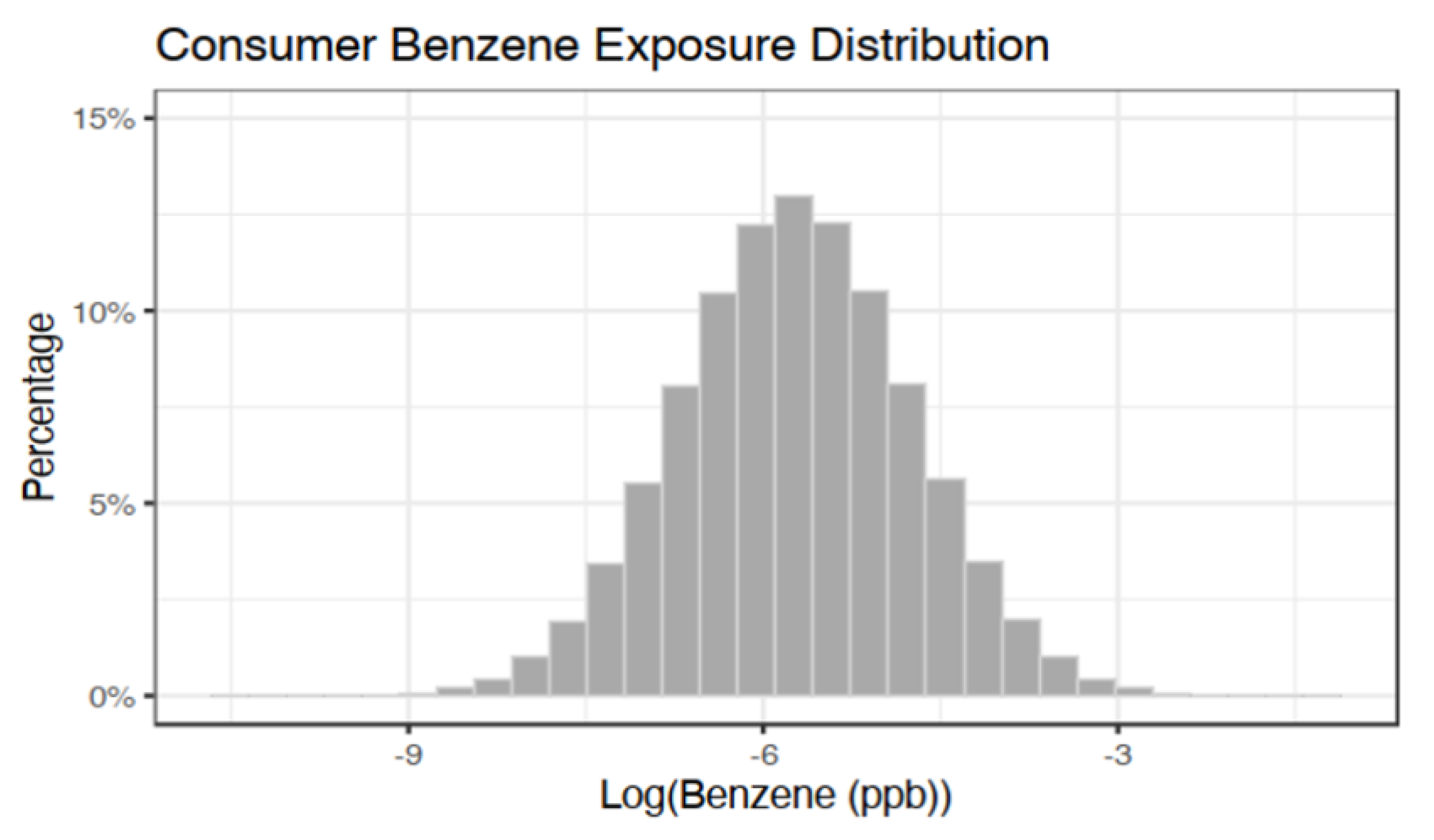
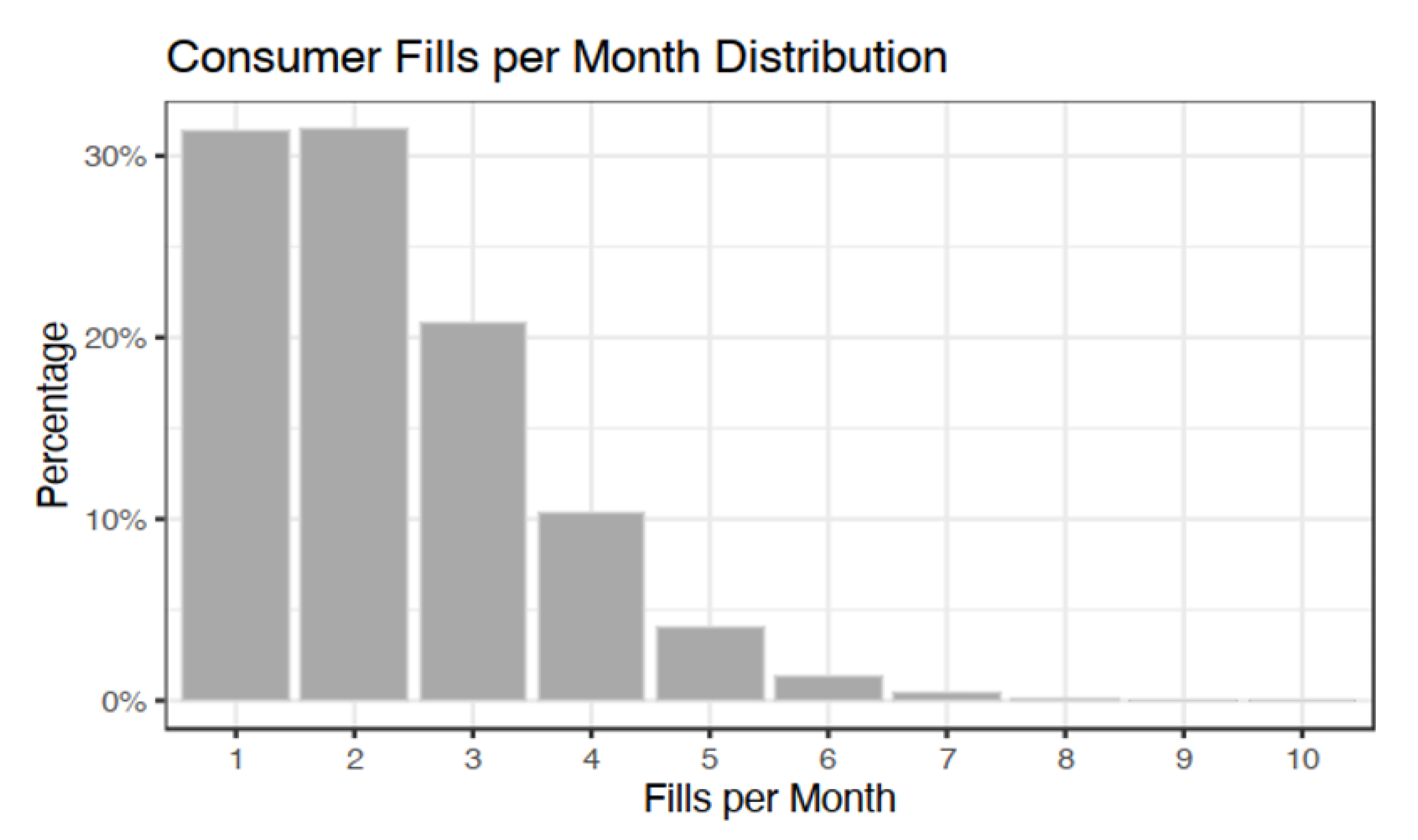

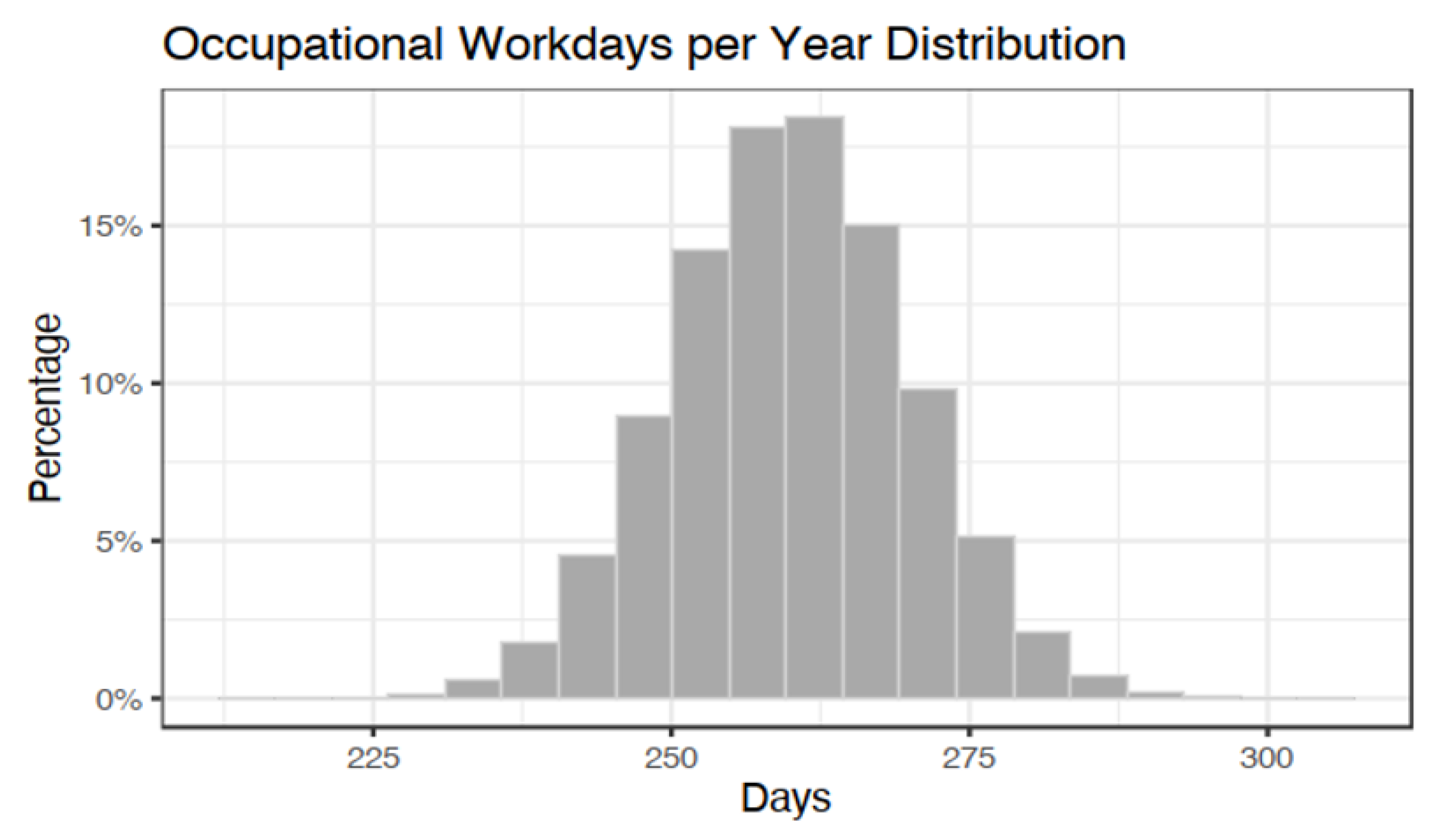
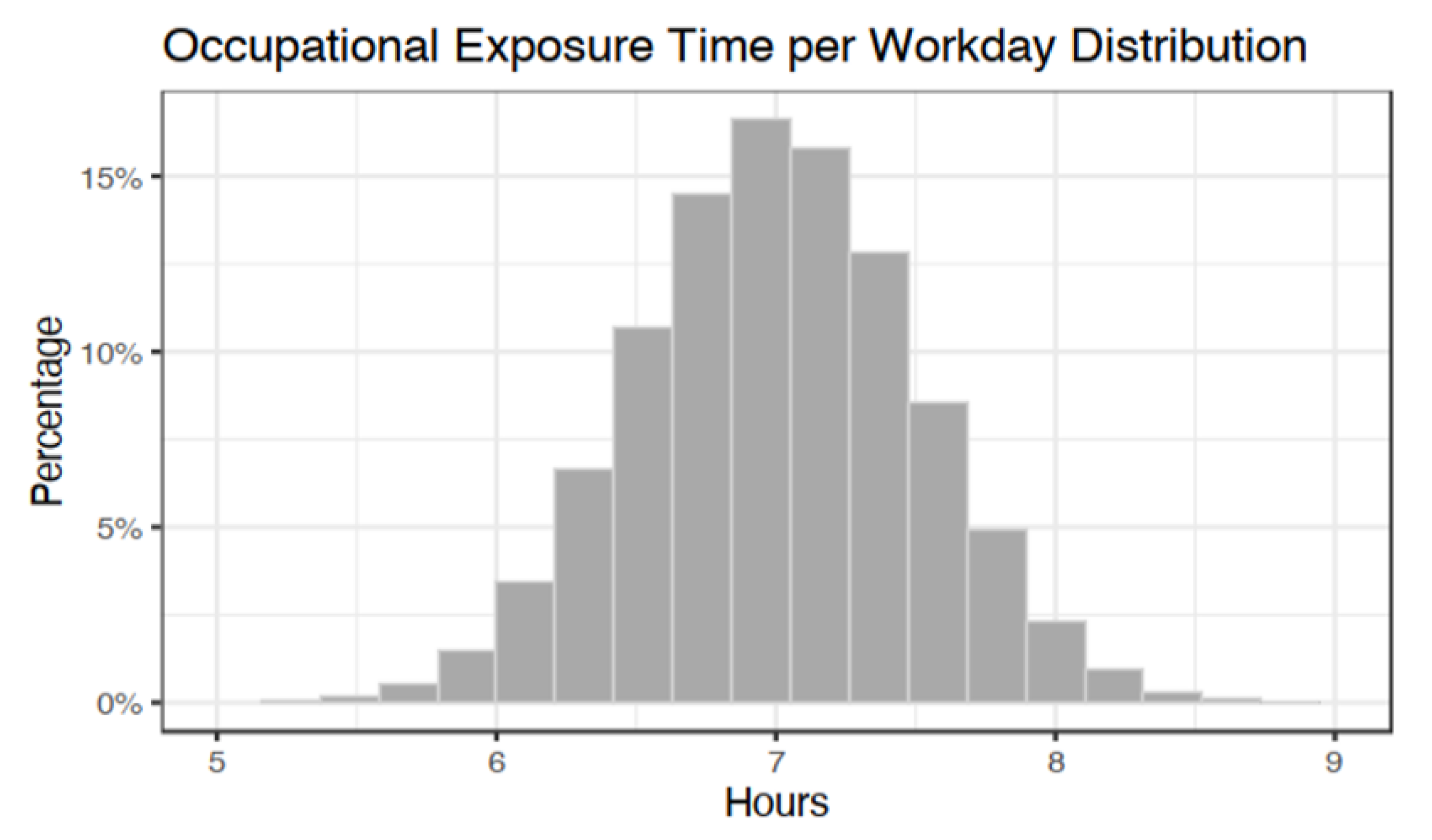
References
- National Association of Convenience Stores NACS. Selling America’s Fuel; National Association of Convenience Stores NACS: Alexandria, VA, USA, 2019. [Google Scholar]
- NACS. Convenience Stores Fuel America; NACS: Alexandria, VA, USA, 2013. [Google Scholar]
- National Association of Convenience Stores Fueling America. A Snapshot of Key Facts and Figures; National Association of Convenience Stores Fueling America: Alexandria, VA, USA, 2013. [Google Scholar]
- Agency for Toxic Substances and Disease Registry. Toxicological Profile for Gasoline; Agency for Toxic Substances and Disease Registry: Atlanta, GA, USA, 1995. [Google Scholar]
- IARC. Gasoline. Monographs 1989, 45, 159–199. [Google Scholar]
- Alternative Fuels Data Center. Ethanol Blends; Alternative Fuels Data Center: Washington, DC, USA, 2017. [Google Scholar]
- Agency for Toxic Substances and Disease Registry. Toxicological Profile for Benzene; Agency for Toxic Substances and Disease Registry: Washington, DC, USA, 2006. [Google Scholar]
- Integrated Risk Information System. Benzene: CASRN 71-43-2; National Center for Environmental Assessment: Washington, DC, USA, 2003. [Google Scholar]
- Bergsagel, D.E.; Wong, O.; Bergsagel, P.L.; Alexanian, R.; Anderson, K.; Kyle, R.A.; Raabe, G.K. Benzene and Multiple Myeloma: Appraisal of the Scientific Evidence. Blood 1999, 94, 1174–1182. [Google Scholar] [CrossRef] [PubMed]
- Paxton, M.B.; Chinchilli, V.M.; Brett, S.M.; Rodricks, J.V. Leukemia risk associated with benzene exposure in the pliofilm cohort: I. Mortality update and exposure distribution. Risk Anal. 1994, 14, 147–154. [Google Scholar] [CrossRef]
- Paxton, M.B.; Chinchilli, V.M.; Brett, S.M.; Rodricks, J.V. Leukemia risk associated with benzene exposure in the pliofilm cohort. II. Risk estimates. Risk Anal. 1994, 14, 155–161. [Google Scholar] [CrossRef] [PubMed]
- Wong, O. Risk of acute myeloid leukaemia and multiple myeloma in workers exposed to benzene. Occup. Environ. Med. 1995, 52, 380–384. [Google Scholar] [CrossRef] [PubMed]
- Keenan, J.J.; Gaffney, S.; Gross, S.A.; Ronk, C.J.; Paustenbach, D.J.; Galbraith, D.; Kerger, B.D. An evidence-based analysis of epidemiologic associations between lymphatic and hematopoietic cancers and occupational exposure to gasoline. Hum. Exp. Toxicol. 2013, 32, 1007–1027. [Google Scholar] [CrossRef]
- Environmental Protection Agency. Gasoline Mobile Source Air Toxics; Environmental Protection Agency: Washington, DC, USA, 2012. [Google Scholar]
- Bruckner, J.; Anand, S.; Warren, A. Toxic Effects of Solvents and Vapors. In Casarett & Doull’s Toxicology: The Basic Science of Poisons; Klaasen, C., Ed.; McGraw Hill: New York, NY, USA, 2008; pp. 981–1051. [Google Scholar]
- Environmnetal Protection Agency. 2014 National Air Toxics Assessment; EPA: Washington, DC, USA, 2018. [Google Scholar]
- Environmnetal Protection Agency. 2014 NATA Summary of Results; EPA: Washington, DC, USA, 2018. [Google Scholar]
- Verma, D.K.; Johnson, D.M.; Shaw, M.L.; Des Tombe, K. Benzene and Total Hydrocarbons Exposures in the Downstream Petroleum Industries. AIHAJ-Am. Ind. Hyg. Assoc. 2001, 62, 176–194. [Google Scholar] [CrossRef]
- Verma, D.; Johnson, D.; McLean, J. Benzene and total hydrocarbon exposures in the upstream petroleum oil and gas industry. AIHAJ-Am. Ind. Hyg. Assoc. 2000, 61, 255–263. [Google Scholar] [CrossRef]
- Page, N.P.; Mehlman, M. Health Effects of Gasoline Refueling Vapors and Measured Exposures At Service Stations. Toxicol. Ind. Health 1989, 5, 869–890. [Google Scholar] [CrossRef]
- Northeast States for Coordinated Air Use Management. Evaluation of the Health Effects from Exposure to Gasoline and Gasoline Vapors; Northeast States for Coordinated Air Use Management: Boston, MA, USA, 1985. [Google Scholar]
- OSHA. OSHA Annotated Table Z-1; OSHA: Washington, DC, USA, 2020. [Google Scholar]
- Periago, J.F.; Prado, C. Evolution of Occupational Exposure to Environmental Levels of Aromatic Hydrocarbons in Service Stations. Ann. Occup. Hyg. 2005, 49, 233–240. [Google Scholar] [CrossRef] [PubMed]
- BLS. Industries at a Glance: Gasoline Stations: NAICS 447. Ind. a Glance.; BLS: Washington, DC, USA, 2019. [Google Scholar]
- Weller, C. Oregon now requires people to pump their own gas—and some New Jerseyans are freaking out. Bus. Insid. 2018. [Google Scholar]
- Nobile, T. NJ coronavirus could have residents pumping their own gas. NorthJersey 2018. [Google Scholar]
- Hornung, R.W.; Reed, L.D. Estimation of Average Concentration in the Presence of Nondetectable Values. Appl. Occup. Environ. Hyg. 1990, 5, 46–51. [Google Scholar] [CrossRef]
- National Institute for Occupational Safety and Health. HYDROCARBONS. In NIOSH Manual of Analytical Methods; Centers for Disease Control and Prevention: Atlanta, GA, USA, 2003. [Google Scholar]
- Center for Environmental Research Information. Compendium of Methods for the Determination of Toxic Organic Compounds in Ambient Air: Method TO-15; Center for Environmental Research Information: Cincinatti, OH, USA, 1999. [Google Scholar]
- Environmental Protection Agency. The Risk Assessment Guidelines of 1986; EPA: Washington, DC, USA, 1987. [Google Scholar]
- National Institute for Occupational Safety and Health. How NIOSH Conducts Risk Assessments; National Institute for Occupational Safety and Health: Washington, DC, USA, 2017. [Google Scholar]
- Integrated Risk Information System (IRIS). Benzene-Carcinogenicity Assessment for Lifetime Exposure; Integrated Risk Information System (IRIS): Washington, DC, USA, 2000. [Google Scholar]
- Richardson, D.B. Temporal Variation in the Association between Benzene and Leukemia Mortality. Environ. Health Perspect. 2008, 116, 370–374. [Google Scholar] [CrossRef]
- Rinsky, R.A.; Hornung, R.W.; Silver, S.R.; Tseng, C.Y. Benzene exposure and hematopoietic mortality: A long-term epidemiologic risk assessment. Am. J. Ind. Med. 2002, 42, 474–480. [Google Scholar] [CrossRef]
- Glass, D.C.; Sim, M.R.; Fritschi, L.; Gray, C.N.; Jolley, D.J.; Gibbons, C. Leukemia risk and relevant benzene exposure period?Re: Follow-up time on risk estimates. Am. J. Ind. Med. 2004, 45, 222–223. [Google Scholar] [CrossRef]
- Finkelstein, M.M. Leukemia after exposure to benzene: Temporal trends and implications for standards. Am. J. Ind. Med. 2000, 38, 1–7. [Google Scholar] [CrossRef]
- Galbraith, D.; Gross, S.A.; Paustenbach, D. Benzene and human health: A historical review and appraisal of associations with various diseases. Crit. Rev. Toxicol. 2010, 40, 1–46. [Google Scholar] [CrossRef]
- Environmental Protection Agency. Risk Assessment Forum White Paper: Probabilistic Risk Assessment Methods and Case Studies; EPA: Washington, DC, USA, 2014. [Google Scholar]
- Daniels, R.; Gilbert, S.; Kuppusamy, S.; Kuempel, E.; Park, R.; Pandalai, S.; Smith, R.; Wheeler, M.; Whittaker, C.; Schulte, P. Current Intelligence Bulletin 69-NIOSH Practices in Occupational Risk Assessment; National Institute for Occupational Safety and Health: Washington, DC, USA, 2020. [Google Scholar]
- National Institute for Occupational Safety and Health. CDC-NIOSH Pocket Guide to Chemical Hazards-Toluene. NIOSH Pocket Guid. to Chem. Hazards; National Institute for Occupational Safety and Health: Washington, DC, USA, 2019. [Google Scholar]
- International Agency for Research on Cancer. Toluene. IARC Summ. Eval. 1999, 71, 829. [Google Scholar]
- National Institute for Occupational Safety and Health. CDC-NIOSH Pocket Guide to Chemical Hazards o-Xylene. NIOSH Pocket Guid. to Chem. Hazards; National Institute for Occupational Safety and Health: Washington, DC, USA, 2019. [Google Scholar]
- International Agency for Research on Cancer. Xylenes. IARC Summ. Eval. 1999, 71, 1189. [Google Scholar]
- National Institute for Occupational Safety and Health. CDC-NIOSH Pocket Guide to Chemical Hazards-Ethyl benzene. NIOSH Pocket Guid. to Chem. Hazards; National Institute for Occupational Safety and Health: Washington, DC, USA, 2019. [Google Scholar]
- International Agency for Research on Cancer. Ethylbenzene. IARC Summ. Eval. 2000, 77, 227. [Google Scholar]
- Office of Personnel Management. Fact Sheet: Computing Hourly Rates of Pay Using the 2,087-Hour Divisor. Policy, Data, Overs. Pay Leave; Office of Personnel Management: Washington, DC, USA, 2011. [Google Scholar]
- National Institute for Occupational Safety and Health. CDC-NIOSH Pocket Guide to Chemical Hazards-Benzene. NIOSH Pocket Guid. to Chem. Hazards; National Institute for Occupational Safety and Health: Washington, DC, USA, 2019. [Google Scholar]
- Agency for Toxic Substances and Disease Registry. Automotive Gasoline; Agency for Toxic Substances and Disease Registry: Atlanta, GA, USA, 1996. [Google Scholar]
- National Institute for Occupational Safety and Health. NIOSH Potential Occupational Carcinogens|NIOSH|CDC; National Institute for Occupational Safety and Health: Washington, DC, USA, 2018. [Google Scholar]
- Adami, G.; Larese, F.; Venier, M.; Barbieri, P.; Lo Coco, F.; Reisenhofer, E. Penetration of benzene, toluene and xylenes contained in gasolines through human abdominal skin in vitro. Toxicol. Vitr. 2006, 20, 1321–1330. [Google Scholar] [CrossRef] [PubMed]
- Williams, P.R.D.; Sahmel, J.; Knutsen, J.; Spencer, J.; Bunge, A.L. Dermal absorption of benzene in occupational settings: Estimating flux and applications for risk assessment. Crit. Rev. Toxicol. 2011, 41, 111–142. [Google Scholar] [CrossRef] [PubMed]
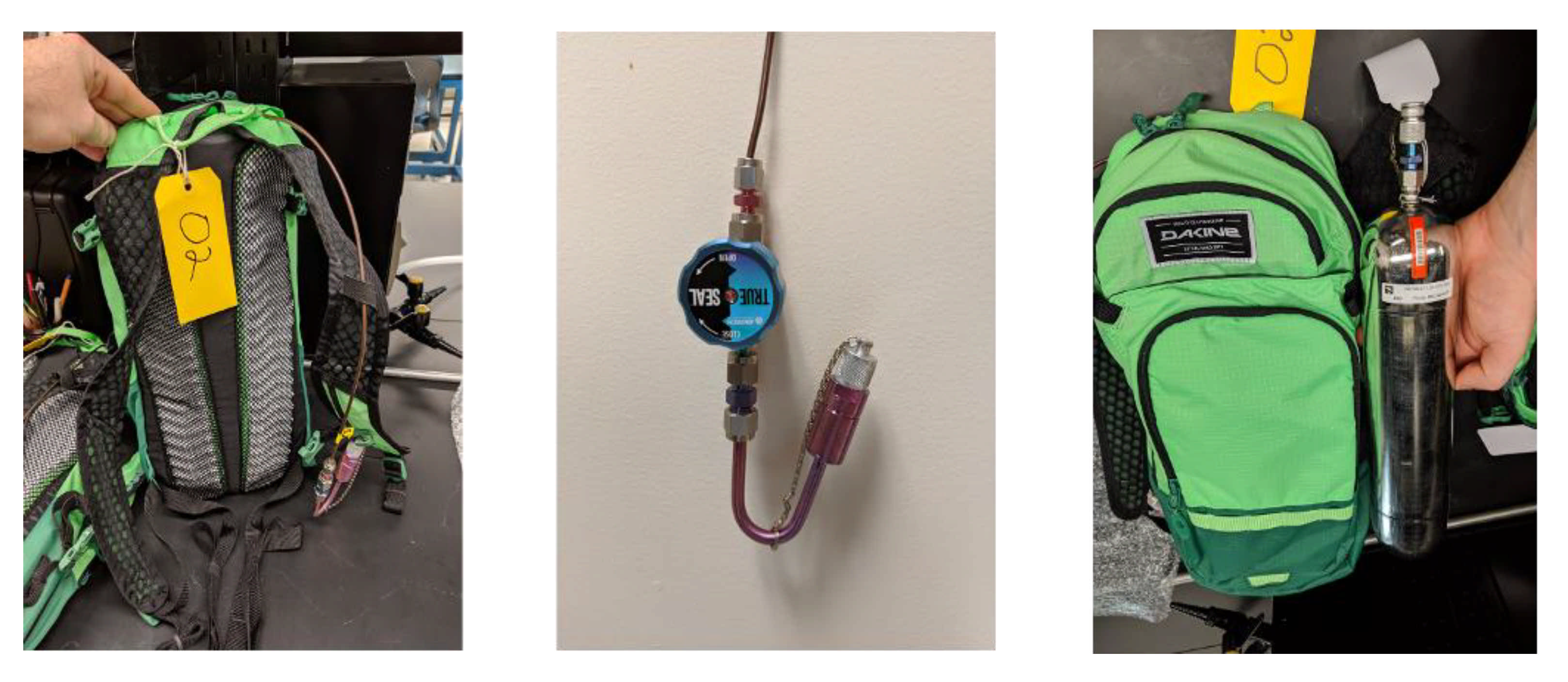
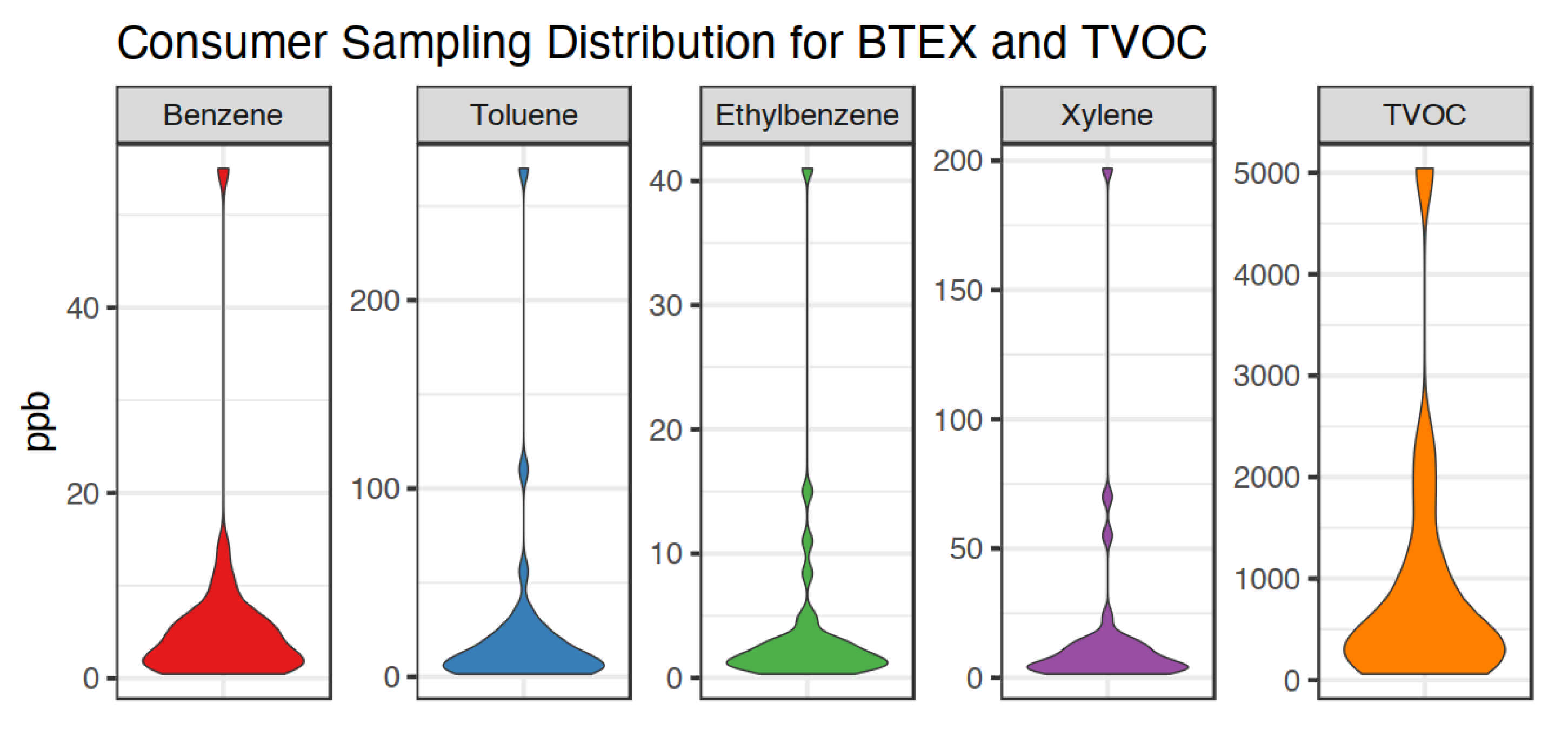
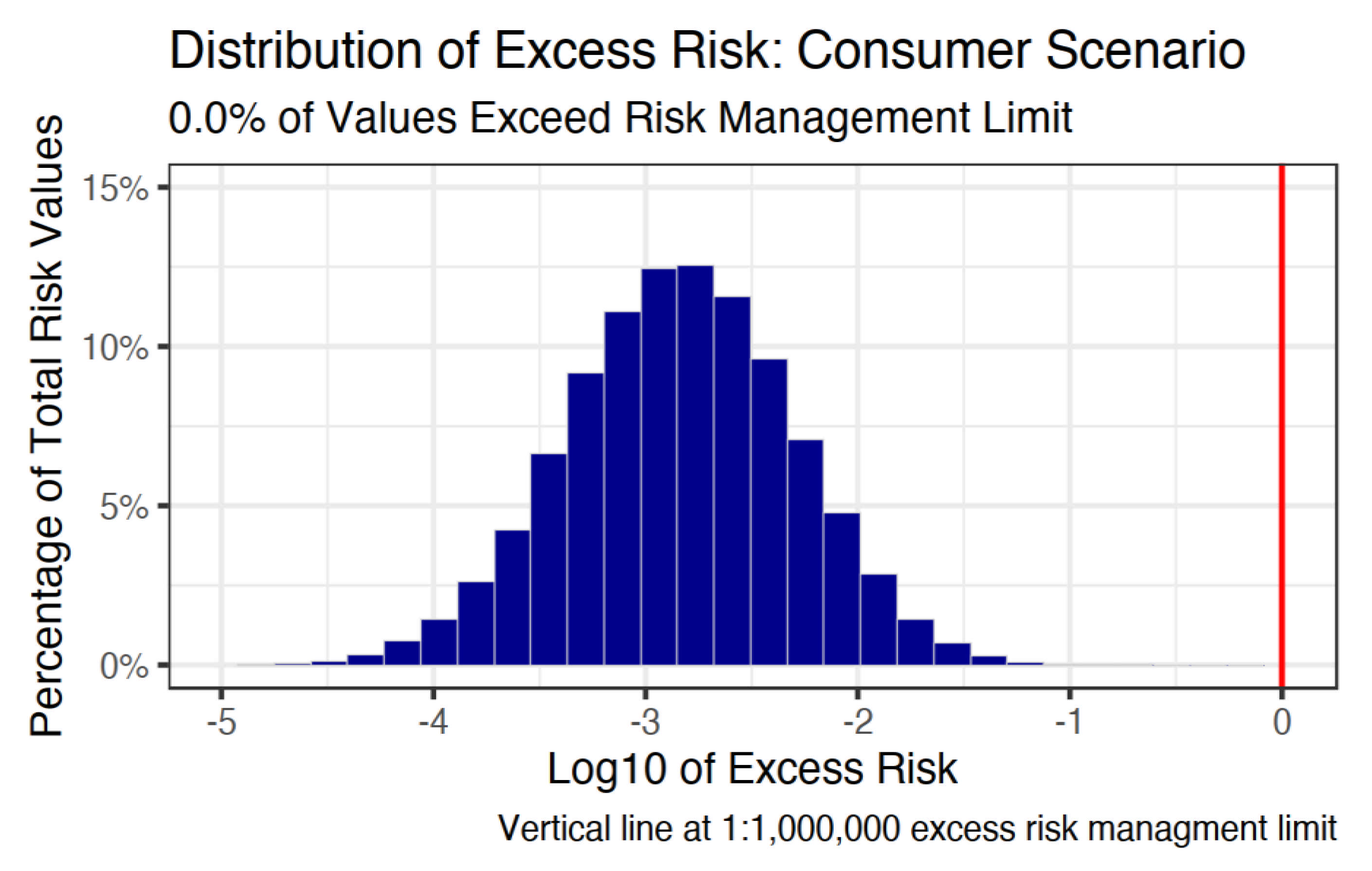
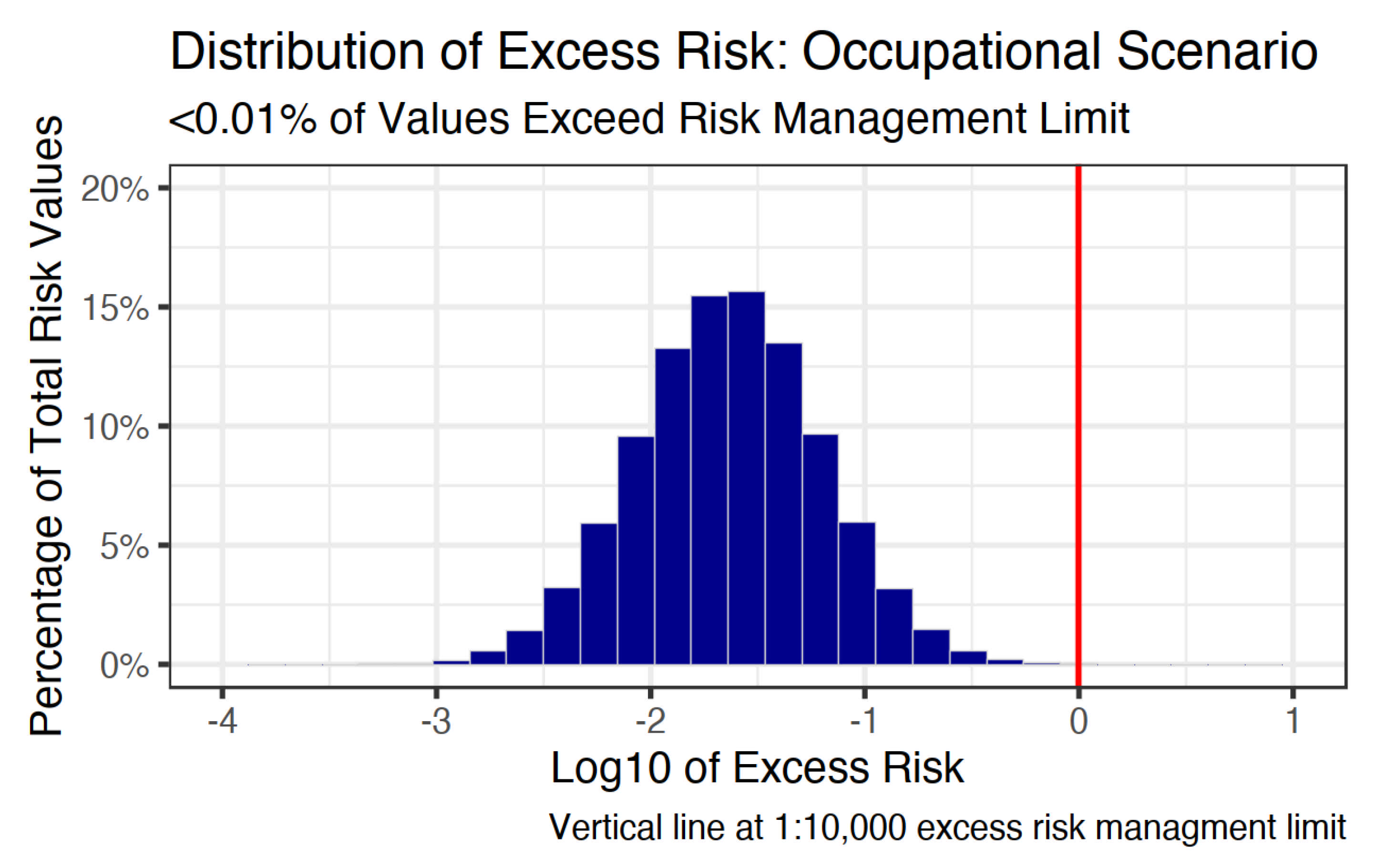
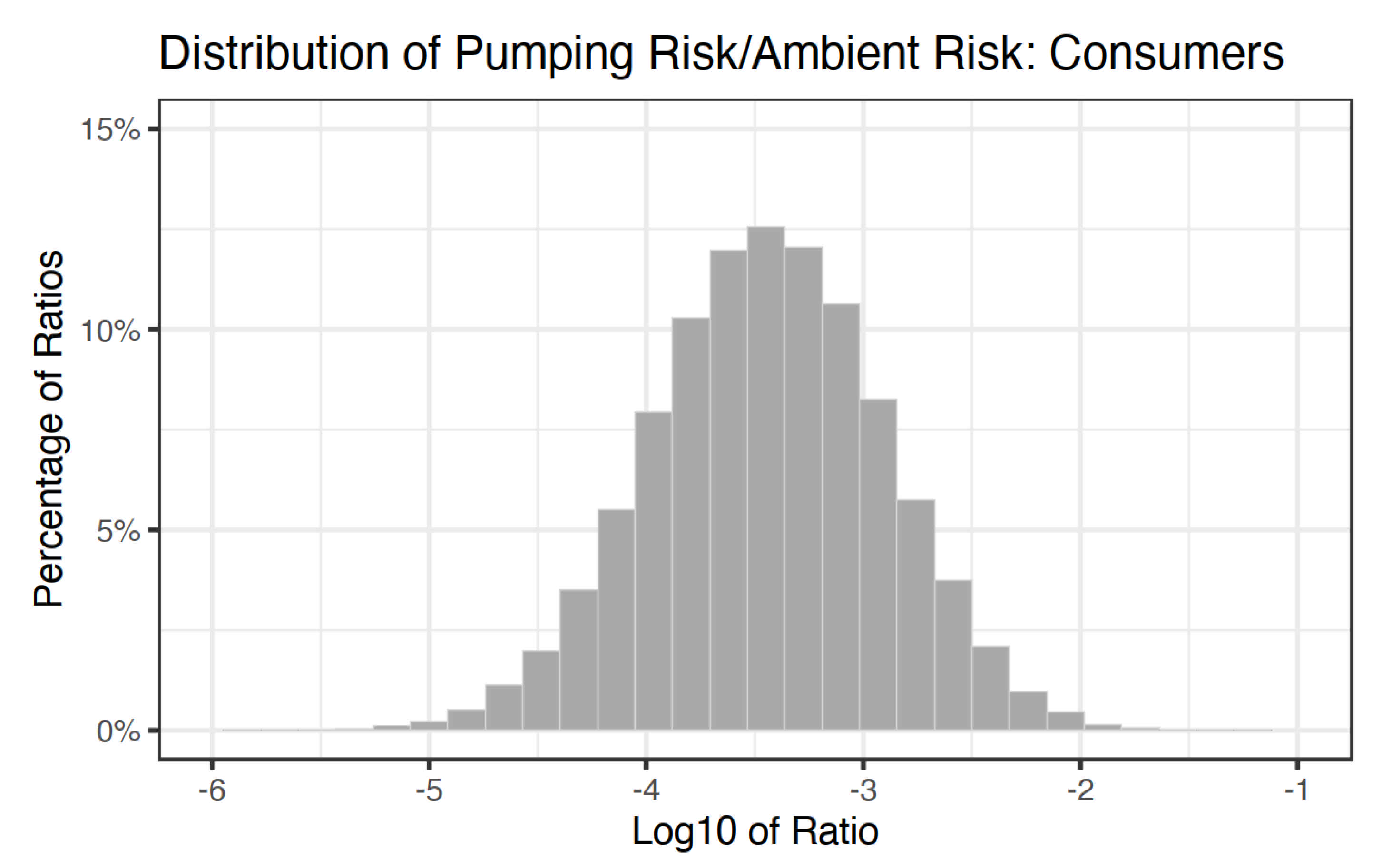

| Data | Variable | Value |
|---|---|---|
| Benzene Concentration | CA | N(x, µ)Log(Benzene) |
| Exposure Time | ET | Ntrunc(x, µ, min = 0.5, max = 6)Min/Fill |
| Exposure Frequency | EF | Pois(λ)Fill Days/Month |
| Exposure Duration | ED | 15 years |
| Averaging Time | AT | 70 years |
| Unit Risk | UR | 2.2 × 10−6 |
| Data | Variable | Value |
|---|---|---|
| Benzene Concentration | CA | N(x, µ)Log(Benzene) |
| Exposure Time | ET | N(7, 0.5)Work Hours/Day |
| Exposure Frequency | EF | N(260, 10)Workdays/Year |
| Exposure Duration | ED | 15 years |
| Averaging Time | AT | 70 years |
| Unit Risk | UR | 2.2 × 10−6 |
| Compound | Geo. Mean (ppb) | Geo. SD | Min (ppb) | Max (ppb) |
|---|---|---|---|---|
| Benzene | 3.24 | 2.72 | 0.49 | 55 |
| Toluene | 9.50 | 3.50 | 1.50 | 270 |
| Ethylbenzene | 1.99 | 2.80 | 0.32 | 41 |
| Xylene | 7.32 | 3.01 | 1.50 | 197 |
| TVOC | 487.00 | 3.06 | 61.04 | 5042 |
| Data | Variable | Value |
|---|---|---|
| Benzene Concentration | CA | N(−5.73, 0.98)Log(Benzene) |
| Exposure Time | ET | Ntrunc(3.08, 1.56, min = 0.5, max = 6)Min/Fill |
| Exposure Frequency | EF | Pois(2)Fill Days/Month |
Publisher’s Note: MDPI stays neutral with regard to jurisdictional claims in published maps and institutional affiliations. |
© 2021 by the authors. Licensee MDPI, Basel, Switzerland. This article is an open access article distributed under the terms and conditions of the Creative Commons Attribution (CC BY) license (http://creativecommons.org/licenses/by/4.0/).
Share and Cite
Patton, A.N.; Levy-Zamora, M.; Fox, M.; Koehler, K. Benzene Exposure and Cancer Risk from Commercial Gasoline Station Fueling Events Using a Novel Self-Sampling Protocol. Int. J. Environ. Res. Public Health 2021, 18, 1872. https://doi.org/10.3390/ijerph18041872
Patton AN, Levy-Zamora M, Fox M, Koehler K. Benzene Exposure and Cancer Risk from Commercial Gasoline Station Fueling Events Using a Novel Self-Sampling Protocol. International Journal of Environmental Research and Public Health. 2021; 18(4):1872. https://doi.org/10.3390/ijerph18041872
Chicago/Turabian StylePatton, Andrew N., Misti Levy-Zamora, Mary Fox, and Kirsten Koehler. 2021. "Benzene Exposure and Cancer Risk from Commercial Gasoline Station Fueling Events Using a Novel Self-Sampling Protocol" International Journal of Environmental Research and Public Health 18, no. 4: 1872. https://doi.org/10.3390/ijerph18041872
APA StylePatton, A. N., Levy-Zamora, M., Fox, M., & Koehler, K. (2021). Benzene Exposure and Cancer Risk from Commercial Gasoline Station Fueling Events Using a Novel Self-Sampling Protocol. International Journal of Environmental Research and Public Health, 18(4), 1872. https://doi.org/10.3390/ijerph18041872







